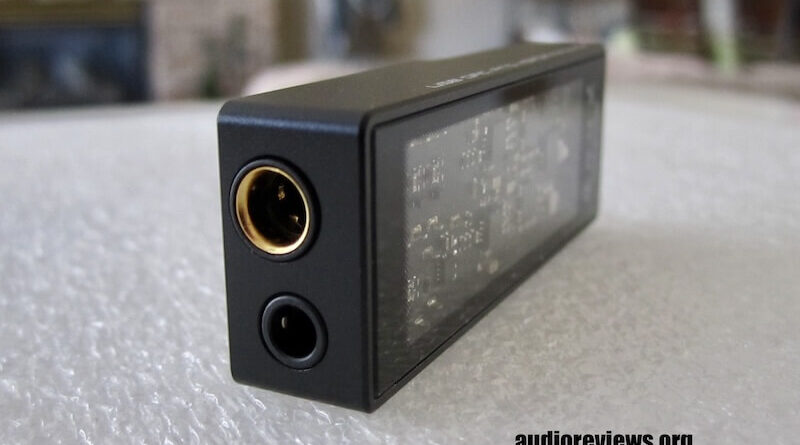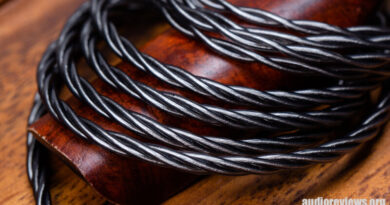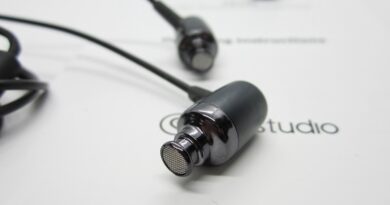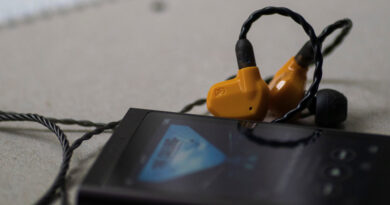SMSL D10 Review – Power Sucker
The SMSL D10 is an optical appealing, VERY powerful, neutral and good sounding dongle with a standard DAC-amp all-in-one chip that makes it sonically similar to identical to many competitors using the same. The price of its power is an excessive current draw from the host device. The output current is surprisingly low, making it unsuited for low-impedance headphones.
PROS
- Decent sound
- Very powerful
- Attractive design
- Built well
- Small
CONS
- Widely used all-in-one DAC-amp chip limited SMSL’s engineering ingenuity
- Manufacturers’s power specs unrealistic
- Current draw way too high
- Not suited for low-impedance headphones
- Needs a protective case for preventing scratches on its glass base.
In this Article
The $69.99 SMSL D10 was provided by SHENZHENAUDIO for my review, and I thank them for that. You can purchase it from SHENZHENAUDIO.COM.
Introduction
Dongles, that is small DAC-amp combinations without internal battery of the size of a thumb drive have been around for not even a decade. They were invented for use with a phone on the road as not everybody wants to carry several electronic devices in their pocket. Earlier portables were bulky as they contained a battery.
It took until 2016 when dongle technology was advanced enough in terms of minimal current draw to work with a phone. Downside of a battery-less design was limited power needed to conserve the host phone’s battery.
This sparked the attention of chip makers and audio engineers and led to a dongle mania with hundreds of models.
Today’s phones have much bigger batteries which allows for much more powerful dongles. We therefore have two dongle end members: such that conserve phone battery and such that deliver much power. Both is not possible because of Ohm’s law.
Our team has had excellent experience with SMSL desktop units, Durwood and Loomis are SMSL fanboys. The company joined the dongle bandwagon rather late with the D10 being their first model. It features two Cirrus 43131 All-In Ones with DAC and amp on one chip, just like the BLON V1, FiiO X Jade Audio KA11, FiiO KA13, iBasso DC04 PRO, iBasso DC07PRO, and Shanling UA1 Plus. The input of SMSL’s engineering ingenuity was strongly limited.
Since it impossible to bypass the amp on such all-in-one chip and also to add proprietary software, all these dongles have a very similar sound, prefabricated by Cirrus. The audio engineer may add different filters and tag on another amp module. Therefore, none of these budget dongles is sticking out and the main differences should be features and optical appeal.
You can read more on All-in-Ones here.
Specifications SMSL D10
| DAC-Amp: 2*Cirrus 43131 All-In Ones Input: USB (Asynchronization) Output: 3.5 mm single ended AND 4.4 mm balanced Compatibility: Mac, Windows (11 needs driver), Linux, iOS, Android Max Output Level: 2 Vrms Output Power: 500 mW (@ 16 Ω and 32 Ω), 160 mW @ 150 Ω , 80 mW @ 300 Ω , 40 mW @ 600 Ω) ThD + N (Non-Weighting): 0.00015% (116 dB) Dynamic Range: 121 dB SNR: 121 dB Sampling Rate: PCM 44.1 ~ 384 kHz, DSD 2.8224 ~ 11.2896 MHz Bit Depth: Power (Draw): 5V/200 mA Size: 55*11*20 mm Weight: 17 g Tested at: $69.99 Purchase link: SHENZENAUDIO.COM |
Physical Things and Functionality
In the box are the D10, a USB-C to USB-C cable, and the usual paperwork. The D10’s body is made of metal with transparent parts on top and bottom, made of glass or acrylic. A protective case would have been beneficial to avoid scratching. The D10 sports a USB-C port for connecting to its music source (plug-n-play), two headphone jacks (3.5 mm single ended and 4.4. mm balanced), and a single button for volume.
I admit that I like such simplicity (no screens, filters, and other distractions), and the volume controlling is rather smooth, the device rests comfortably between my fingers. A blue LED shines through the glass on top and bottom when music is playing.




Amplification and Power Management
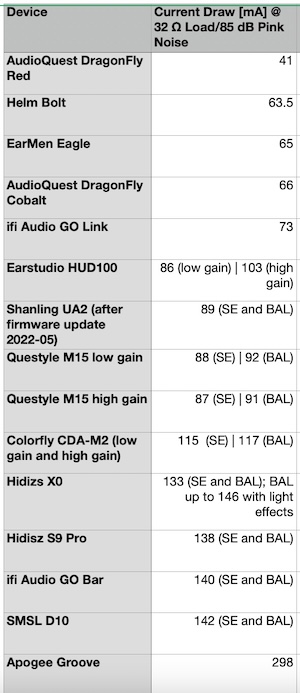
Ouch, ouch, ouch. The SMSL D10 has the highest current draw of all dongles I have tested (ignoring the exceptionally monstrous Go Bar and the Apogee Groove). More than twice the draw than the AudioQuest DragonFly Cobalt, and 40% more than the powerful Questyle M15.
The D10 will therefore suck your phone’s battery dry much faster than its competitors. And even if you reduce the volume substantially, the current drain does not decrease at all. Not acceptable.
On the other hand, plugged into my MacBook Air, the SMSL D10 does not deliver enough current to my 14 ohm final E5000 earphones keeping its bass mushy.
Where did all that current it drew from my phone go?
Swapping the final E5000 for the Sennheiser 300 ohm HD 600 works fine. The Senns play with pizazz. You can get quite a healthy volume out of them. Way more than one would expect, despite the fact that the manufacturer’s specs are likely vastly exaggerated – and need to be confirmed by independent measurements.
The SMSL has a very poor power management, to the point that is is problematic for pairing with phones.
Sound
| Equipment used: Macbook Air/iPhone SE first generation/final E5000, Dunu Zen, Sennheiser HD 600, HD 25, IE 600, and IE 900. |
I only tested the balanced circuit as it provides more depth and three-dimensionality than a single-ended one – and it delivers more power.
The SMSL D10 sounds pretty much flavour neutral, nothing harsh or sterile, maybe with a smidgen of warmth, without being offensive. As said, the sound largely comes from the two standard Cirrus 43131 All-In One chips (one for each channel) we know from so many similarly priced dongles.
As to sound-quality details, it is the old glass half full or half empty, depending how you look at it. My HD 600 log good upper and lower extension with decent spatial cues, but the amp could be a bit speedier (especially at the low end) with a tad more transparency. Having said that, I really enjoy listening to my testing playlist, the sound is more than adequate for the road, hotels, office etc. And if you (don’t even) look at the small size of this device and its price, you are astonished what it does with the Senns.
With the naturally spicier Dunu Zen iems, the sound comes across as a bit sharper, compared to the more relaxed and smoother AudioQuest DragonFly Cobalt.
It is, in the end, a mainstream sound well prefabricated by Cirrus, with an afterburner added by SMSL that gives it additional power (and current drain). Probable best used with a computer.
Concluding Remarks
The SMSL D10 is an optically very appealing device (for many) but technically an average Joe on steroids with a very poor power management: it has lots of power for higher-impedance headphones (only) and, unfortunately, also an unruly high power drain from its host device while providing relatively little current to our low-impedance headphones.
As to the sound: make sure you don’t already have a device with these Cirrus 43131 All-In-One chips, or you buy the same over and over again.
Summing up, the D10 is a niché product that performs satisfactorily only with very limited pairings. If this fits your purpose, the $69.99 price is right.
Until next time…keep on listening!

Disclaimer
Our generic standard disclaimer.



